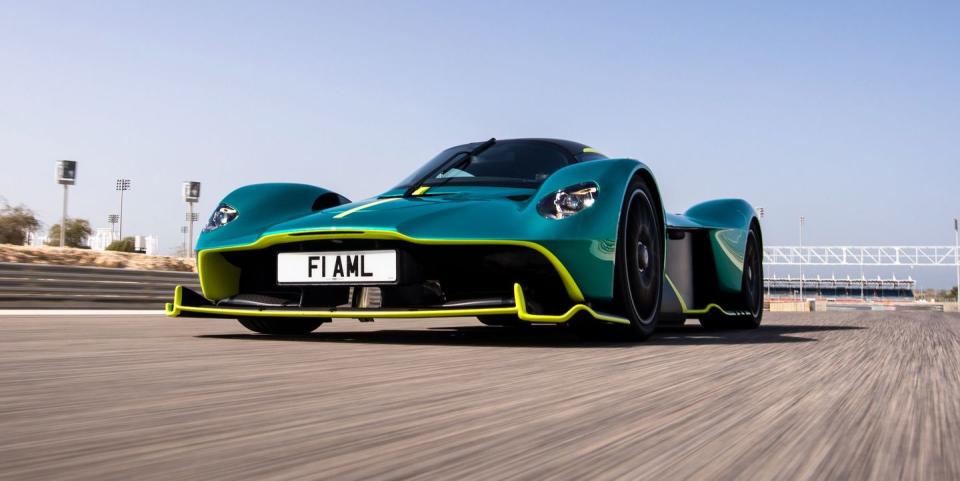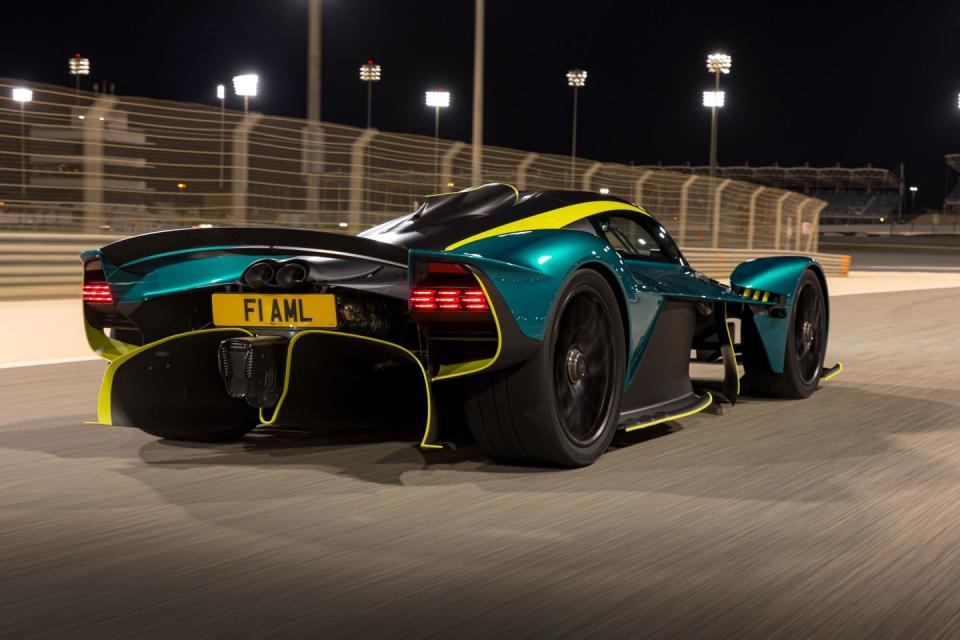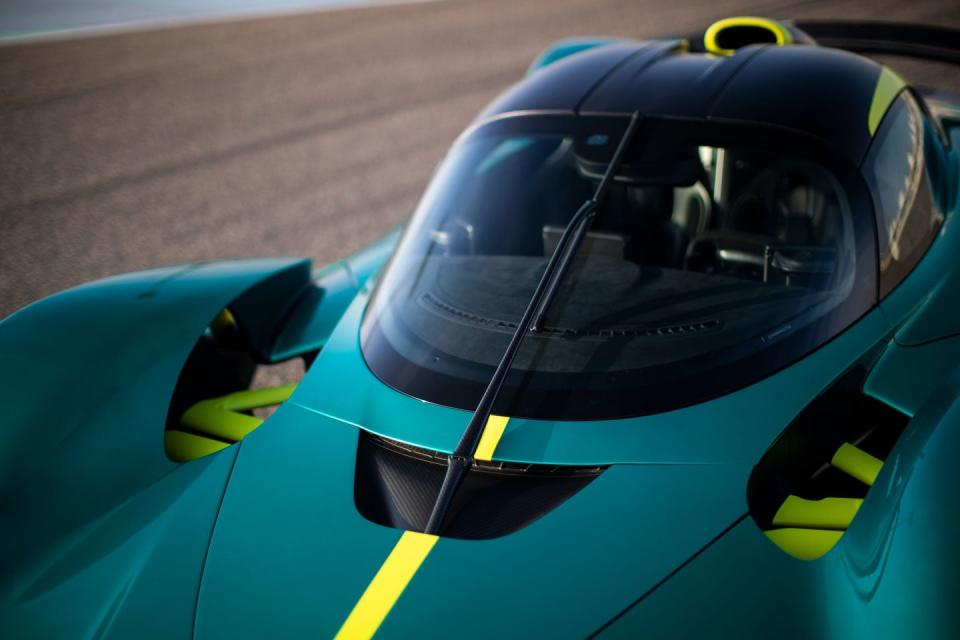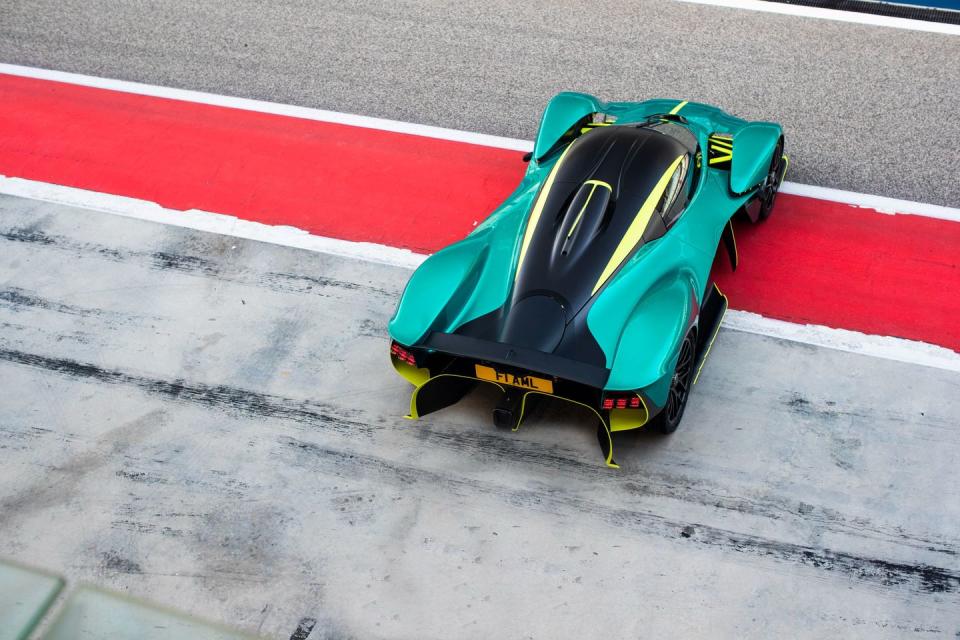Taking the Aston Martin Valkyrie for a 186-MPH Ride around Bahrain’s F1 Track

While the Aston Martin Valkyrie coupe screams on the Bahrain International Circuit, it is a fully street-legal car.
The Valkyrie coupe draws power from a Cosworth engineered naturally aspirated 6.5-liter V12 turning out 1001 hp by itself, assisted by a 141-hp electric motor that sits between the V12 and the seven-speed sequential transmission driving the rear wheels.
Only 150 Valkyrie coupes will be built, and all are already sold—at more than $3 million a pop.
Let’s park the question of why until later, because the what of the Aston Martin Valkyrie is astonishing enough. This is a car born from the long-running dream of Formula 1’s most famous designer, Adrian Newey, to make a street-legal hypercar. The collaboration between his current Red Bull Racing team and Aston Martin began in 2015, and there have been plenty of ups and downs on the Valkyrie’s way to market. The project has outlasted two Aston Martin CEOs, and—with Aston now competing directly against Red Bull in Formula 1—the partnership behind it has already been dissolved, with both Aston and RBR working on their next mid-engined models separately. So the Valkyrie’s parents were divorced by the time it was born.
Only 150 Valkyrie coupes will be built, all already sold, with each costing slightly more than $3 million at current exchange rates. Smaller runs of the track-only Valkyrie AMR Pro and a roofless Valkyrie Spider will follow. All will use the same basic engine, a Cosworth engineered naturally aspirated 6.5-liter V12, which uses a racing-style gear-driven camshafts and revs to an extraordinary 11,200 rpm. The engine produces 1001 hp by itself, and is assisted—in the road-going cars—by a 141-hp electric motor that sits between the V12 and the seven-speed sequential transmission driving the rear wheels. The result is a combined peak of 1142 hp, in a car that weighs just 2800 pounds dry.

The Valkyrie is a road car in a legalistic rather than a practical sense. It wears license plates, sits on street-legal tires and passes European-type approval homologation requirements—although US buyers will need to drive theirs under ‘show and display’ exemption. But the needs of human cargo came low on Newey’s priority list. Although it is beautifully finished in carbon and microfiber, the cabin is tiny and cramped in almost every dimension. Once installed, a driver’s ankles are pretty much at the same height as their backside. The lower padding had to be removed from the bucket seat to allow me to sit with my helmeted head not grazing the roof. The view forward is truly special, though, looking through a heavily curved wraparound windshield that could belong to a Group C racer.
Nor, despite the road legality, did I get to experience the Valkyrie on road. The first drive was limited to the Bahrain International Circuit, ahead of Formula 1’s season-opening Grand Prix there. An exotic location with limited correlation to the real world—but also one of the few places to allow the Valkyrie to be fully extended.
Because fast isn’t a strong enough word to describe the scale of the Valkyrie’s performance. The basic physics of so much power pushing so little mass are compelling enough, but the savagery with which the engine delivers its urge is what makes it feel truly exceptional. Even on the circuit’s longer straightaways it took time to build up the confidence necessary to run all the way to the engine’s altitudinous redline, such is the scale of the mechanical cacophony inches behind the passenger compartment.

Even experienced through the padding of a helmet the V12 is almost painfully loud, and to attempt to experience it without any form of ear protection would be a shortcut to tinnitus or hearing loss. Like most race cars, the engine is mounted directly to the carbon fiber tub as well, adding high frequency buzzing vibration to the maelstrom. In objective terms, the Valkyrie is toweringly fast: I saw an indicated 186 mph at the end of Bahrain’s kilometer-long start-finish straight and still left a cautious distance for braking. But subjectively, it feels even quicker than those numbers suggest given the level of sound and fury. In terms of visceral excitement, it’s genuinely hard to think of another car that gets close, street legal or not.
While the engine dominates the experience, it isn’t all of it. The chassis uses a variety of active systems including both adaptive dampers and a height adjustment system which, in the most aggressive Track mode, brings the Valkyrie as close as possible to the ground to optimise aerodynamic performance. Airflow over and under the car’s bodywork is managed as carefully as you would expect given its Formula 1 pedigree, with active wing elements front and rear, plus another pair in the huge Venturi tunnel of the diffuser. The result is, Aston says, a peak of up to 2420 lbs of aerodynamic downforce—from 135 mph to the electronically limited top speed of 220 mph—with that number limited by the inability of the road tires to take more. (For reference, the fixed wings of the AMR Pro makes a claimed downforce peak of 5950 lbs, but rides on slicks.)
The Valkyrie’s street-legal tires are the limiting factor in terms of ultimate speed, but this doesn’t diminish the driving experience, even on a wide, open race course. I drove the car riding on the more road-friendly Michelin Pilot Sport Cup 2 rubber; more aggressive Cup Rs are on the options list. There is less grip than there would be in a race car (or track day special) riding on slicks, especially in tighter corners—that being most evident in how hard the traction control has to work to maintain order. But the Valkyrie’s steering delivers a strong sense of connection, and even with the variable traction control turned down, it never turned skittish or snappy. On quicker parts of the circuit downforce built quickly, creating a sense of huge dynamic stability and the ability to carry what felt like impossible speed through faster turns.

Yes, all this took place on a wide, dry, and otherwise empty racetrack, one with margins guarded by huge asphalt run-off areas. There is no doubt the Valkyrie would be a different and much more intimidating proposition in the real world or on a slippery surface. While it is road-legal, it is definitely not a car designed for the sort of relaxed grand touring Aston Martin products are most famous for.
While braking performance is huge, the demonstrator’s pedal had a slight dead feeling at the top of its travel, and softened slightly under repeated hard stops. To be fair to the Valkyrie, it had already managed multiple stints on track before my turn to drive it. The engine also struggled with the ambient temperature of Bahrain a couple of times, derating by cutting the rev limiter as the coolant temperatures soared. Driving around in a high gear for half a lap or so restored it to health, and it shouldn’t be an issue in cooler parts of the world.
The answer to “why?” is ultimately a simple one: awesomeness. Nobody who agreed to pay more than $3 million for the Valkyrie did so expecting practicality or comfort. They signed on for Adrian Newey’s vision to create something devoid of compromise. It was the single-minded insistence that performance be prioritized above almost everything else that makes it feel like a pinnacle. This is the most hyper of all hypercars—for now at least.

 Yahoo Autos
Yahoo Autos 